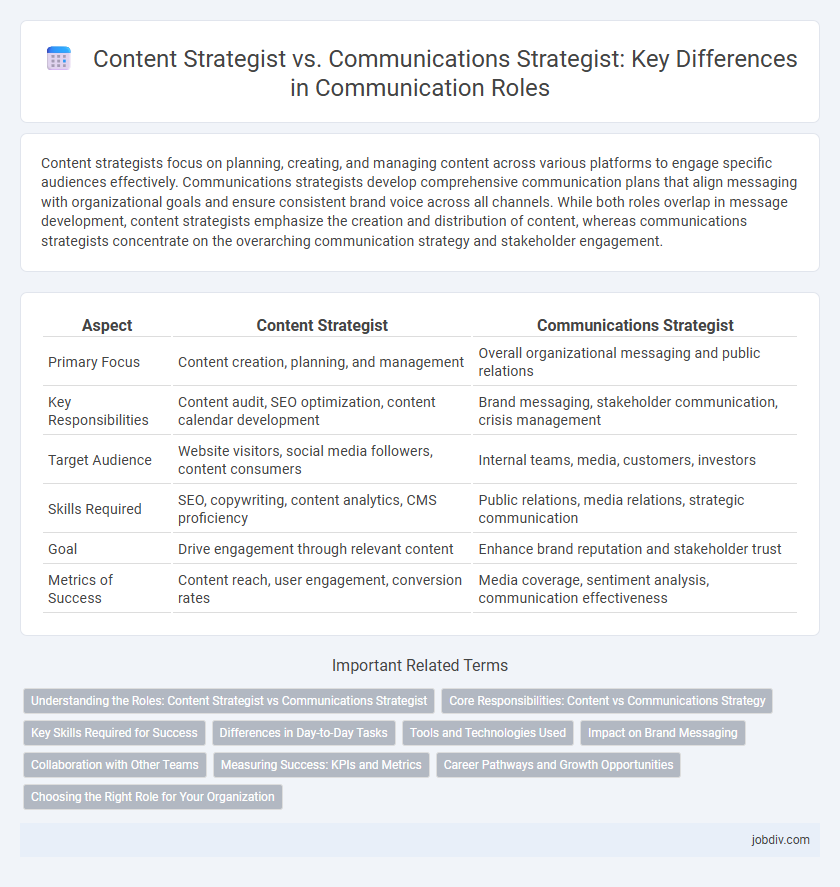Content strategists focus on planning, creating, and managing content across various platforms to engage specific audiences effectively. Communications strategists develop comprehensive communication plans that align messaging with organizational goals and ensure consistent brand voice across all channels. While both roles overlap in message development, content strategists emphasize the creation and distribution of content, whereas communications strategists concentrate on the overarching communication strategy and stakeholder engagement.
Table of Comparison
| Aspect | Content Strategist | Communications Strategist |
|---|---|---|
| Primary Focus | Content creation, planning, and management | Overall organizational messaging and public relations |
| Key Responsibilities | Content audit, SEO optimization, content calendar development | Brand messaging, stakeholder communication, crisis management |
| Target Audience | Website visitors, social media followers, content consumers | Internal teams, media, customers, investors |
| Skills Required | SEO, copywriting, content analytics, CMS proficiency | Public relations, media relations, strategic communication |
| Goal | Drive engagement through relevant content | Enhance brand reputation and stakeholder trust |
| Metrics of Success | Content reach, user engagement, conversion rates | Media coverage, sentiment analysis, communication effectiveness |
Understanding the Roles: Content Strategist vs Communications Strategist
A Content Strategist focuses on planning, creating, and managing content tailored to target audiences across platforms to drive engagement and brand consistency. In contrast, a Communications Strategist develops overarching messaging frameworks and manages internal and external communications to align organizational goals with stakeholder perceptions. Both roles intersect in shaping brand narratives, yet the Content Strategist centers on content execution while the Communications Strategist oversees strategic communication and reputation management.
Core Responsibilities: Content vs Communications Strategy
Content Strategists focus on developing, managing, and optimizing a brand's content across various platforms to engage target audiences effectively. Communications Strategists design and implement comprehensive communication plans that align messaging, audience engagement, and media relations to support organizational goals. Core responsibilities differ as Content Strategists prioritize content creation and distribution, while Communications Strategists emphasize message consistency and strategic outreach.
Key Skills Required for Success
Content Strategists excel in content creation, audience analysis, and SEO optimization, ensuring messages align with brand voice and drive engagement. Communications Strategists prioritize stakeholder management, crisis communication, and internal/external communication planning to maintain corporate reputation. Both roles demand strong writing, analytical thinking, and project management skills for successful execution.
Differences in Day-to-Day Tasks
Content Strategists focus on planning, creating, and managing digital content to engage specific audiences, often working closely with SEO, social media, and editorial teams to optimize user experience and brand messaging. Communications Strategists develop and implement comprehensive communication plans that align with organizational goals, managing public relations, internal communications, and crisis communication to shape public perception and stakeholder relationships. The primary difference lies in Content Strategists concentrating on content lifecycle and audience engagement through various media, while Communications Strategists oversee broader messaging strategies and communication channels across multiple platforms.
Tools and Technologies Used
Content Strategists primarily use content management systems (CMS) like WordPress and HubSpot, along with SEO tools such as SEMrush and Ahrefs, to optimize content creation and distribution. Communications Strategists leverage advanced communication platforms including Slack, Microsoft Teams, and social media management tools like Hootsuite and Sprout Social to facilitate internal and external stakeholder engagement. Both roles utilize analytics software, but Content Strategists focus more on content performance metrics while Communications Strategists emphasize message reach and audience interaction data.
Impact on Brand Messaging
A Content Strategist shapes brand messaging by creating targeted, relevant content that enhances audience engagement and supports marketing goals. A Communications Strategist oversees the broader narrative, ensuring consistent messaging across all channels to build brand reputation and stakeholder trust. Both roles critically influence brand perception, but the Content Strategist zeroes in on content creation while the Communications Strategist manages overall communication strategy.
Collaboration with Other Teams
Content strategists collaborate closely with marketing, design, and SEO teams to create cohesive messaging that aligns with brand goals and audience insights. Communications strategists engage cross-functional teams--including PR, legal, and executive leadership--to manage consistent messaging across internal and external channels. Both roles require strong teamwork but differ in their primary focus: content creation versus overarching communication strategy.
Measuring Success: KPIs and Metrics
Content Strategists measure success through KPIs such as engagement rates, page views, and content shareability, emphasizing audience interaction and content performance. Communications Strategists focus on metrics like message reach, media coverage, sentiment analysis, and stakeholder feedback to evaluate the effectiveness of communication campaigns. Both roles leverage data analytics but prioritize different indicators aligned with their distinct strategic objectives.
Career Pathways and Growth Opportunities
Content Strategists focus on developing and managing content across digital platforms, emphasizing SEO, audience engagement, and brand storytelling, creating pathways towards roles like Content Manager or Digital Marketing Director. Communications Strategists specialize in crafting and executing comprehensive communication plans, handling public relations, corporate messaging, and crisis management, leading to opportunities such as Communications Director or Chief Communications Officer. Both career paths offer growth through skills in analytics, leadership, and strategic planning, with a rising demand fueled by digital transformation and integrated marketing strategies.
Choosing the Right Role for Your Organization
A Content Strategist focuses on planning, creating, and managing content to engage specific audiences and drive brand narratives. A Communications Strategist develops broader messaging frameworks and oversees internal and external communication channels to align with organizational goals. Choosing the right role depends on whether your organization needs targeted content delivery or comprehensive communication alignment across all platforms.
Content Strategist vs Communications Strategist Infographic

 jobdiv.com
jobdiv.com